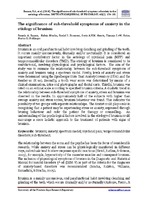| dc.contributor.author | Basson, Reneda | |
| dc.contributor.author | Mwaba, Kelvin | |
| dc.contributor.author | Rossouw, Roelof | |
| dc.contributor.author | Geerts, Greta | |
| dc.contributor.author | van Wyk Kotze, Theuns | |
| dc.contributor.author | Stuhlinger, Martin E. | |
| dc.date.accessioned | 2014-07-01T14:03:14Z | |
| dc.date.available | 2014-07-01T14:03:14Z | |
| dc.date.issued | 2010 | |
| dc.identifier.citation | Basson, R.A., et al. (2010). The significance of sub-threshold symptoms of anxiety in the aetiology of bruxism. South African Journal of Psychology, 40(2): 174-181 | en_US |
| dc.identifier.issn | 0081-2463 | |
| dc.identifier.uri | http://hdl.handle.net/10566/1113 | |
| dc.description.abstract | Bruxism is an oral parafunctional habit involving clenching and grinding of the teeth. It occurs mainly unconsciously, diurnally and/or nocturnally. It is considered an important contributory factor in the aetiology of myofacial pain (MFP) and temporomandibular disorders (TMD). The etiology of bruxism is considered to be multifactorial, involving physiological and psychological factors. The aim of the study was to examine the relationship between the sub-threshold symptoms of anxiety and bruxism using a spectrum model. Firstly, levels of anxiety and stress were determined using the Spielberger State Trait Anxiety Inventory (STAI) and the Kessler-10 (K-10). Secondly, a tooth wear score was determined by means of a clinical examination, intra-oral photographs and dental casts. Thirdly, bruxism was rated on an ordinal scale according to specified bruxism criteria. A dualistic trend in the relationship between sub-threshold symptoms of anxiety, stress and bruxism was observed in the results. In approximately half of the subjects with higher than average anxiety and stress scores, bruxism behaviour was found. This indicates the possibility of two groups with separate relationships. The dentist could play a role in recognizing that a patient may be experiencing stress or anxiety, expressed through bruxing behaviour and refer the patient for therapy or counselling. An understanding of the psychological factors involved in the etiology of bruxism could encourage a more holistic approach to the treatment of patients with signs of bruxism. | en_US |
| dc.language.iso | en | en_US |
| dc.publisher | South African Journal of Psychology | en_US |
| dc.rights | © 2010 SAGE Publications. | |
| dc.source.uri | http://dx.doi.org/10.1177/008124631004000207 | |
| dc.subject | Anxiety | en_US |
| dc.subject | Bruxism | en_US |
| dc.title | The significance of sub-threshold symptoms of anxiety in the aetiology of bruxism | en_US |
| dc.type | Article | en_US |
| dc.privacy.showsubmitter | false | |
| dc.status.ispeerreviewed | true | |
| dc.description.accreditation | Web of Science | en_US |

